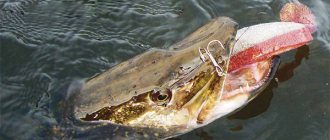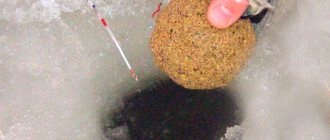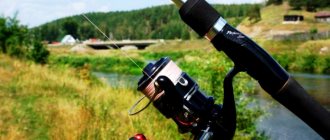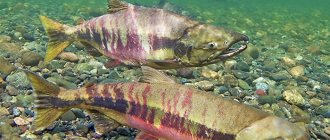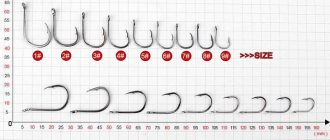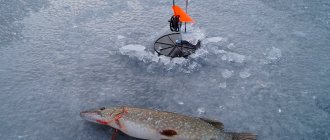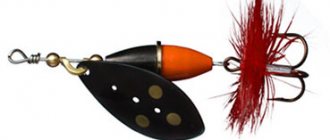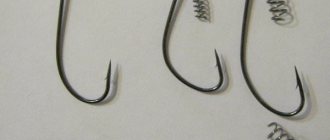Types of hooks for catching pike
Catching pike is a labor-intensive process, but under the right conditions it can show the best results. In this case, not only the current and depth of the water are important, but also the quality of the gear, including the hook. You need to pay attention to the size, design, shape and other parameters of the hook, which will undoubtedly affect the amount of catch. There are several types of pike hooks:
- Offset.
- Double hook or double.
- Tee.
The shape and size of the hook directly depend on the size of the expected catch, the method of baiting the bait and other parameters. For example, a large hook will not allow the pike to capture it completely. A hook that is too small will not be able to grip the fish's mouth sufficiently.
The most optimal hook size for catching pike is considered to be a hook number 3-7.
Sometimes fishermen construct special gear consisting of 2 or 3 hooks. It is important that before hunting the hook is so sharp that it can easily penetrate the body of the fish even with the slightest attack. Let's take a closer look at the features of each type of hook.
Photo: Pike on a hook
Offset (single)
This hook is a specially designed option that is designed to replace a conventional single hook for hunting predatory fish. It has a special shape - it has a special bend on the fore-end (the part of the hook from the head to the beginning of the hook) and is usually used when fishing with a spinning rod.
Offset hook
Offset hooks can be used for such types of installation as:
- Texas rig – suitable for fishing in thickets and snags.
- A retractable leader that performs best when catching calmer fish.
- Carolina rig is most suitable for live bait play.
- The drop shot is most often used for catching passive pike from a high bank, vertically or casting from a boat.
Double (double hook)
This type of hook is often used by fishermen in winter to install girders. The double is very convenient to remove from the depths of the pike’s mouth with minimal damage. It is also easy to attach live bait to catch small fish. The bait must be chosen of the appropriate size, since a small hook and a large nozzle will not give the expected result, although they will not cling to snags. Conversely, a large double and a small bait will cause constant snags in thickets and snags.
Live bait can be attached to such a hook in several ways. The most popular baits are under the gills, behind the back and behind the lip of live bait. Compared to a single hook, a double hook provides a greater chance of getting a bite, which is why it is popular with most fishermen.
Tee
Treble hooks are most often used in mid-water or sandy ponds where they are rarely likely to snag on anything. They can be used both in summer and winter. They can also be used for fishing with spoons, wobblers or balancers. One of the significant disadvantages of tees is their bulkiness, which increases the likelihood of them getting caught on snags. In addition, when fishing for pike, it sticks deep into its mouth, so it is difficult to remove it without special equipment.
About
Pike circle
A catchy and at the same time compact tackle for catching pike is a circle. Its largest element is the disk. It is made from polystyrene foam, linden, or another type of wood, polypropylene. You can also find plastic mugs in the store, but they are far from the best option. It’s better to buy a homemade one, made from polystyrene foam. Wooden ones require more care; they need to be impregnated with varnish, and not every angler has time for this.
The simplest and at the same time working option is to take fine-grained polystyrene foam or polypropylene foam and paint it with red waterproof paint. We paint only the top part. To make a circle, just take a tin can without a lid and press it tightly onto the foam. Then twist it a little with pressure and cut a circle. As a result, we will get an even blank for the circle. All that remains is to make a groove on the side for winding the fishing line. It can be done with a knife or file. Then you should smooth out the unevenness with medium and fine sandpaper. It is important to ensure that the edges are smooth and the line does not cling to roughness.
We make a hole in the center of the disk into which we will insert a pin - another basic element of this gear. At the bottom, the pin has a thickening that blocks the movement of the pin through the hole in the circle. A slot is made in the upper part of the rod for the fishing line. The circle looks like this:
The fishing line used is thick 1-2 mm. If you have a nylon cord of the same thickness, then that will do. Its length depends on the depth of casting the tackle. After immersion in water, approximately 6 meters of fishing line should remain on the mug. This is done so that the pike, after capturing the bait, has the opportunity to walk with it for a while without feeling the tension of the cord. It is necessary to tie a piece of monofilament several meters long with a diameter of 0.4 mm to the fishing line. A sliding sinker in the shape of an olive weighing up to 20 grams is attached to the end of this segment. If there is a larger live bait on the hooks, then we set the weight heavier. Next, a leash with a hook is attached through the clasp. In general, the gear looks like this:
Anglers have arguments and discussions about which hook to use. Some people fish with a double bait, as it is less damaging to live bait. The tee, of course, catches fish better. It can be used when active fishing is going on and live bait does not stay on the hooks for a long time. On doubles, they retain their marketable appearance longer and attract fish more. The length of the leash is usually 15-20 cm, but not more than 30 cm. Tees and doubles are used No. 3-5.
Non-snacking hooks for pike and their features
Underwater vegetation and snags often become an obstacle to a good catch, although it is in the dense thickets that the most fish are found. Pike is one of those fish that love algae and are found in places where vegetation, snags and stones accumulate. In such cases, when it is impossible to reach fish with ordinary baits, fishermen come to the aid of special non-snagging hooks, which show excellent results in snags. Most often, non-hooking rods are used when fishing for pike with a spinning rod.
Non-hooking boats may differ in their shape and design, but they all help to develop hard-to-reach and promising areas of reservoirs. The main types of non-hooking baits are jig baits, spinnerbaits, non-hooking spoons, gliders and others:
- Non-hooking lures have protection in the form of wire with special springs, fishing lines, some can even be hidden inside the baits. The principle of operation of such hooks is to bend the wires on a spring at the moment the pike grabs, as a result of which the fish can be detected. Minnow brand spinners are considered the most popular among unhooked ones.
- For lovers of jig fishing, offset hooks with silicone coating are offered, that is, the hook is hidden inside the silicone, which passes through the thickets without hindrance. There are also foam rubber baits with a double, the grip of which compresses the foam rubber, and the pike becomes prey.
- Gliders are most often used as bait for surface fishing. They have a voluminous shape and light weight, which is achieved due to the plastic used in manufacturing. Inside it there is a hook and a weight, and the non-hook itself easily slides along the surface, creating vibrations on the water. In its appearance and shape, the bait imitates small rodents or frogs.
- Spinnerbaits are considered one of the popular lures for spinning, although they are not so versatile for hunting in dense thickets and are successful mainly in snags.
Ice fishing gear
In winter, pike are caught using stakes (winter girders), and tackle for vertical trolling.
Winter girders
The most common factory rate model consists of the following parts:
- plastic bracket with coil;
- square or round stand with a slot for fishing line;
- a flat spring signaling device with a bright red flag at the end;
- equipment - 10-15 meters of monofilament fishing line with a thickness of 0.3-0.35 mm, an olive sinker weighing 6-8 grams, a steel or tungsten leash with a tee No. 2/0-3/0
Experienced winter pikemen advise placing such girders near the shore, on the upper and lower edges of sharp slopes, and in deep holes. The most convenient is a two-row checkerboard arrangement of these gears.
Thanks to its simple design, such tackle can not only be bought at a fishing store, but also made with your own hands by performing the following manipulations:
- On a wooden round pole 30-40 cm long, using a self-tapping screw, secure a reel from under the fishing line with a soldered small handle. The reel should rotate freely, releasing the line when biting.
- A square stand with a slot for a fishing line and a hole for a pole is cut out of a piece of waterproof plywood using a jigsaw.
- Apply a signaling spring to the top, fixing it with a small casing made of outer insulation from a thick cable.
- A fishing line is wound onto the reel, a sliding sinker and a silicone stopper are put on, and a leash with a hook is attached.
All wooden parts of homemade gear are torn with black oil paint. To store and carry the girders, use a homemade freezer box with several compartments and a convenient harness.
You can see more clearly how to make such a tackle for pike fishing in the following video:
Tackle for vertical trolling and fishing on a balance beam
For winter fishing for pike with a balance beam, vertical spoons, and a bulldozer, a carbon fiber rod 40-70 cm long with an inertial reel with a diameter of 6-7 cm with a 25-30 meter supply of monofilament fishing line with a cross section of 0.22-0.27 mm wound around it is used. a thin tungsten 10 cm leash.
Finnish hook for pike
This type of hook has been known to anglers for a long time and is one of the most effective methods of successful fishing. It is made of steel spring wire 1 mm thick. It is easy to make, so many fishermen make it themselves.
A peculiarity of its design is that its fore-end is usually short and does not reach the gills of the fish, and there are 2 sharp barbels on it. Thanks to this structure, it easily falls into the throat and then into the stomach of the predator, after which the hook antennae stick into the tissue and become spaced, and sometimes the hook even comes out along with the entrails.
About
What kind of hook is needed to catch pike?
There are many opinions about which type of hook is most suitable for catching pike. Some use single hooks, some use treble hooks, but many agree that you need to choose a hook depending on the type of baitfish and the method of baiting it. In addition, hooks for pike fishing are selected depending on the type, length and height of the bait. When buying artificial fish, it is best to place them on the hook in order to understand how well it will sit on it.
Experienced fishermen also advise paying attention to such parameters as the quality of the wire, the width of the hook, the hook antennae bent inwards and the method of attaching the hook to the leader.
Doubles or tees
Doubles
These hooks are used for long-term fishing. The shank of the hook is passed through the gills of the baitfish, and the stings protrude from its mouth. You can use crucian carp or perch as live bait. Depending on which fish predominates in the pike’s habitat. The positive effect of this method of baiting is excellent camouflage. When swallowing live bait, the predator does not feel the hook, so the chance of an unsuccessful bite or the bait breaking tends to zero.
|
Another advantage is that this method does not injure live bait and allows you to carefully remove the hook and reuse it on your next fishing trip.
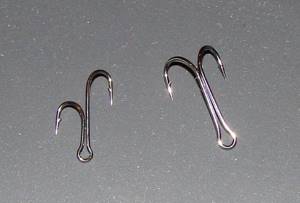
The disadvantage of doubles will be the long wait for a bite ; if the hooking is done ahead of time, most likely the predator will break and you will have to start all over again. Such fishing will definitely not fill you with vivid emotions, but for those who like a quiet, relaxing atmosphere, this will be an excellent choice.
Tees
When fishing with a tee, fishing will be more dynamic. Pike react faster if perch is used as bait. The advantage is that the predator does not react to injections. However, it is important to choose small hooks with a short shank .
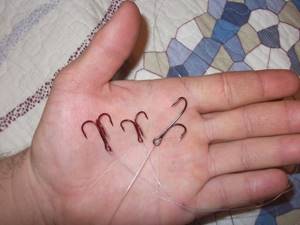
What size hook to choose for pike
As noted above, you first need to decide on the bait, and then select a hook in size for it. If you don’t get the ratio right, you can get fewer hooks on the bottom, but the number of slips and empty bites will also increase. It is important to remember that according to the international classification, as the number increases, the size of the hook becomes smaller. So, the smallest hook is considered to be No. 24.
Offset
For pike fishing, an offset hook of size No. 5/0 is most often used, but the bait must also match it. It is better to choose a hook whose length will be approximately 1/2 the length of the body of the bait.
Double
A double hook of size No. 7 according to domestic numbering will be most suitable for catching pike. According to the international classification, double No. 6-8 is often used.
Tee
When catching pike with live bait, tee No. 3-7 according to international numbering is mainly used. When spinning fishing, treble hooks are also often used.
Installation of a spinning rod for pike
When fishing for pike, use medium-class spinning rods with a fairly rigid action. The stick should throw the bait well and dampen the powerful jerks of the fish. The average length of the rod is 3 meters. If we fish from a boat, then we can use shorter ones from 2.4 to 2.7 meters in length. If ultra-long casts are required, then sticks with a length of 3.5 to 4 meters are suitable.
The rod test usually does not exceed 30 grams. Some anglers prefer rods with split handles. More experienced people prefer twitching spinning rods, which are good for fishing with wobblers.
We use a reel that is not very heavy, up to 250 grams with a spool size of 2500 to 3000. The winding must be correct and even, since a braided line with a diameter of 0.16 mm is wound onto the reel. It is better to buy a more expensive fence with a round cross-section, so that when casting it does not twist into the beards.
The most important element of spinning equipment is the leash. It is better to use a tungsten leash with a length of 15 to 30 cm. Neither pike nor pike perch will bite it.
Which hooks are better
To catch pike, different types of hooks and different techniques for installing them are used. They are selected depending on the time of year, the depth of the reservoir, the gear used and the fishing method. The most important requirement for a hook is its sharpness, since the pike’s mouth is hard and quite toothy, and it can be difficult to hook it securely.
For spinning fishing
The most popular baits for spinning fishing: wobblers, spoons and silicone baits. For each bait, appropriate hooks are selected.
- For oscillating and rotating spinners, single, double and triple hooks are used. Sometimes a hook with 4 or even more hooks is used.
- Wobblers are rarely equipped with double hooks; triple or single hooks are often used.
- Silicone baits are equipped with an offset, double or triple hook.
About
How to remove a pike from a hook
In addition to good equipment and a suitable hook, you need to have a special tool in your arsenal to remove the hook from the fish’s mouth. Zevnik - extractor for pike (fishing clamp or tongs). Of course, the small teeth of a pike will not allow you to bite off a fisherman’s hand or drag a dog near the water, but some precautions still need to be taken.
Using a yawner to remove a hook Yawner and extractor
Photo: Fishing clamp
How to remove a hook from a pike
Correctly remove the hook from a caught pike as follows:
- Having pulled the pike out of the water, you need to lay it with its head to the left; if the angler is right-handed, the glove should also be put on your left hand.
- Next, you should pass 2 fingers along the gill wall into the gap under the jaws and lift the pike’s head so that the mouth opens.
- When hooking correctly, the nozzle should be near the mouth. You can remove it using a fishing clamp. If this is a tee, then you can ask your partner for help to hold the leash.
- Some anglers still use a pike yoke, which helps keep the mouth open to remove the hook.
- If the fish has deeply swallowed the hook, then you can use a special industrial hook remover or extractor.
The use of a barbless hook and proper hooking are a guarantee of unimpeded removal from the predator’s mouth.
For successful pike hunting, it is important to choose the right type of hook. Pay attention to the material it is made of, the bait used and its size. In addition, the type of reservoir, current, time of year and, of course, the weight of the fish itself are of great importance. In order to get a good catch, you should stock up on different types of hooks. And use them, adapting to specific fishing conditions.
Views: 1,472
Similar articles:
- Offset hook: types, sizes, selection, installation The success of any fishing depends not only on the skills of a skilled fisherman...
- Fishing for pike with live bait in winter: which is better? Pike is a dangerous underwater predator that can destroy...
- How to put live bait on a pike hook Fishing with live bait most often makes it possible to catch really large...
- Equipment for silicone baits. How to attach silicone bait to a hook. Silicone baits are artificial baits for catching fish that...
What hooks are best to put on the girders? Features of fishing with doubles and trebles
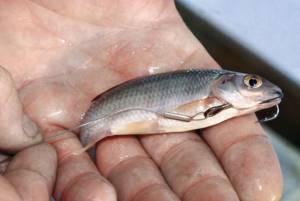
There are so many people, so many opinions - the truth of this phrase is confirmed when choosing hooks for equipping a pike girder in winter. Some people use only singles, others use tees. Again, there is usually no arguing with the choice of size. According to the international classification, numbers 10 or 12 are used.
So what type of hook to use in the girder, we advise you to base your choice depending on the type of baitfish and the method of baiting it.
a single bait is best suited for small white fry when baited by the mouth;
the double is used for mounting a leash under the gills of especially delicate live bait;
The tee is ideal for perches and ruffs when baited behind the back.
On girders, especially in the middle of nowhere, special multi-armed doubles have proven themselves to be excellent. In such a double, the stings are separated at an angle of 90 degrees and the hooks themselves, which make up the double, are of different sizes - one is short and the other is long. Live bait is placed on a short hook under the upper fin. In this case, the long hook is tightly pressed to the side of the baitfish.
During the pike's grip, the predator does not get stuck on the hook and is not embarrassed by anything. Next, the pike begins to swallow the bait. And here she doesn’t feel a catch, since the hook at this moment assumes a horizontal position and its sting does not betray itself in any way. But when hooking, the hook is guaranteed to pierce the soft tissue of the predator’s mouth, or directly into the intestinal wall if the pike has swallowed too deeply. Such tricky hooks used to be soldered independently. Now they are easy to purchase in any fishing department.

They are used in cases where the fisherman needs elegant and delicate equipment, and the size of the live bait does not exceed five centimeters. They help out in the dead of winter, at the end of January - February, when the bellies of pikes are filled with reproductive products - spawning is just around the corner! In such a situation, the most bites will be provided by a tiny roach or bleak, attached to a single fish by the lip or back. And you shouldn’t think that only small bait bites on small bait - catching “three rubles” and “fours” is far from uncommon! This arrangement is also used for targeted fishing for large perch. The disadvantages include low grip - the number of derailments from a single is significantly higher than from a double or tee.
I pass the end of the leash through the gills and mouth from behind. I insert an unsoldered double into the leash in front of my mouth, and pulling it back, I pull the double into my mouth. The sting of the hooks is like a mustache. The pike tries to take from the head, and the hooks go “along the way”. I carefully remove untouched live bait after fishing. Double first, and I pull out the leash. The live bait remains alive until next time. I use crucian carp and rotan as live bait.
I caught both tees and doubles and singles. Depending on the type of hook, the hooking time varies. There is no need to rush with a single hook. With a twin through the gills, too.
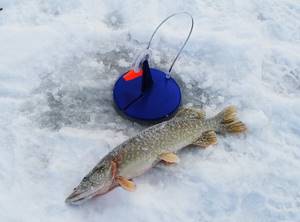
Doubles are used in the so-called “lazy” rig, when the shank of the hook is passed through the gill, and the stings stick out of the baitfish’s mouth. The advantage of such equipment is perfect camouflage - the fish does not feel the hook, holding the bait in its mouth, crushing and swallowing it, and therefore the percentage of empty bites and abandoned or torn live bait tends to zero. Another plus is that this method of baiting does not injure the crucian carp and does not require the angler to “make holes” in its back, and therefore one live bait can be used on more fishing trips.
The disadvantages include the need for a long wait - early hooking almost always means the fish disappears or the bait is pulled out of its mouth. In addition, such a method cannot be called emotional and bright: the fisherman can solve all the pressing issues before going to work, and there are no bright and high-speed runs to the burning vent. Boring!

The pike detects the tee faster, but at the same time it rarely slips out of the mouth without catching the pike. A good live bait for the tee is perch. The pike does not pay attention when it pricks. The main thing about the hooks is their small size. That is, a short fore-end.
Regardless of what type of hook and equipment option is used, you should pay attention to:
Wire quality. The best hooks are made of carbon steel; they actively resist unbending, spring back, and unbend when the applied load is exceeded;
Hook width. Hooks with a narrow hook are of little use; it is the hook that is responsible for the natural position of the bait on the hook and holding the hooked fish. In addition, hooks with a wide hook are much more difficult to straighten;
The sting is curved inward. Such hooks are less noticeable to the fish and do not arouse suspicion in them. As a result, the fish behaves much more actively when biting, and the likelihood that it will be pricked decreases;
As a note, you can note the method of attaching the hook to the leash. My opinion is that when equipping the girders, you need to get rid of carabiners and fasteners first of all. It is better to replace them with a miniature winding ring. Each of us has heard at least one story about how a clasp or carabiner failed the fisherman in the final stage of fishing, unbent or broke. Don't take the risk!
Read other articles, reviews and testimonials:
- Review of ice drills for winter fishing. Pros and cons of Russian and Finnish ice drills
- Norfin Discovery - Winter fishing suit review. Reviews of the Norfin Discovery suit
- Review of the Lucky John Baltic balancer. Reviews from fishermen about balance beams Lucky John Baltic
- Nova Tour Fisherman Nord v.2 - Review of winter fishing suit. Reviews of the suit Nova Tour Fisherman Nord v2
- How to properly catch roach in winter fishing. Winter fishing for roach
